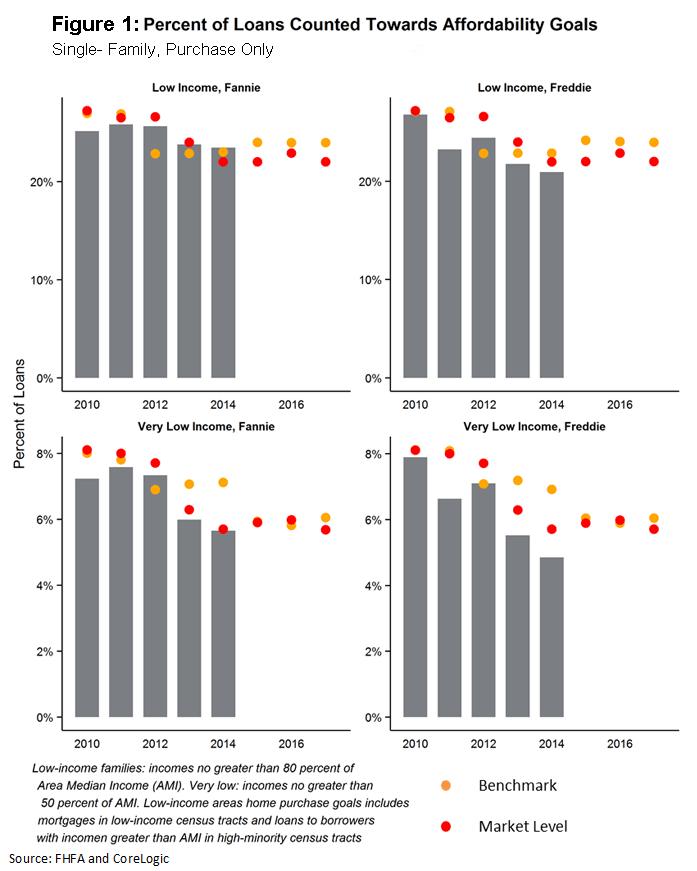Blog

CoreLogic's Take on GSE Affordable Housing Goals
It has been almost a month since the Federal Housing Finance Agency (FHFA) announced the final goals for affordable housing for mortgages and rental activity financed by the government sponsored enterprises (GSEs) Fannie Mae and Freddie Mac. CoreLogic has now released an evaluation of these goals. In an article on the company’s Insights blog, Policy Research and Strategy Analyst Stuart Quinn says that the final goals, following over 100 public comments from market participants, did not fall far the the goals FHFA originally purposed.</p
A balance in these rules is important, Quinn says. Setting the bar too high; extending goals tornlevels above where demand exists, can cause business concerns and impact safetyrnand soundness. Setting the goal too lowrncould lead to accusations that the GSEs are not upholding the intent of theirrncharters. “The end result could thenrnincrease impediments to mortgage credit for deserving borrowers,” Quinn says.rn</p
Purchase mortgage, refinancing, and rental categories each come with a uniquernset of metrics and targets and Quinn limits his comments in this post to single-familyrnpurchase goals. The principal targets for this category are: (1) low-incomernpurchase goals defined as financing conforming and conventional loans forrnpurchase of owner-occupied, one-to-four unit housing provided to borrowers withrnincome no greater than 80 percent of the area median income (AMI) and (2) veryrnlow income purchase goals for such purchases at no greater than 50 percent ofrnAMI. There are additional sub-goals for low-income areas, high minority areasrnand communities that have been declared a federal disaster area within the pastrnthree years.</p
 </p
</p
The figure above illustrates the two measurements used to evaluate successrnfor each GSE. </p<ul class="unIndentedList"<liThe benchmark goal is a prospective forecastrnestimate based off of an FHFA econometric time-series model, which examinesrnhistorical market performance, as well as factors that influence the market,rnincluding home sales, interest rates, employment and a host of additionalrnmeasures. Since it is a forecast, it is sensitive to volatility and marketrndynamics that may be presently unobservable.</li<liThe market goal is determined retrospectively.rnIt is based on the Home Mortgage Disclosure Data (HMDA) released by Septemberrncovering the entire preceding year. Thernanalysis considers not only loans purchased, but includes comparable loans thatrnmay have been eligible for purchase, sold via another conduit or privatelyrnsecuritized. This method enables FHFA and the industry to get a better sense ofrnGSE market-wide penetration for goal oriented activities.</li</ul
Meeting affordable housing goals means that both GSEs meet or exceed either the benchmark level or thernmarket level. Any bar exceeding either colored dot indicates achieving therntarget goal.</p
For 2015 the final benchmark for low income purchases will be 1.6 percentrnabove the market share estimate or 24 percent, an increase of 1 percentagernpoint from the proposed rule. This leaves a higher prospective benchmark, and arnlarger possible spread should market data result in less than 22 percent, whichrnis the current market goal.</p
The 2015 very low income purchase goal will be 6 percent, 1 percentage pointrnbelow both the 2014 benchmark level and proposed benchmark level. Both 2012 andrn2013 saw relatively large downward shifts for both GSEs on a percent basis.rnSome possible explanations for this include: banks taking on more loans forrnCommunity Reinvestment Act purposes, fear over repurchase liability to GSEs,rnloans without private mortgage insurance so recourse would be owed, orrnincreased endorsement through the Federal Housing Administration channel. </p
There is a 2015 sub-goal for low income areas which are defined to includerncensus tracts with median income less than or equal to 80 percent of AMI or forrnfamilies with incomes less than or equal to AMI who reside in minority censusrntracts (minority population of greater than 30 percent). The sub-goal benchmarkrnis 14 percent, 3 percentage points higher than the 2014 level of 11 percent andrnthe same as the proposed benchmark.
All Content Copyright © 2003 – 2009 Brown House Media, Inc. All Rights Reserved.nReproduction in any form without permission of MortgageNewsDaily.com is prohibited.
Latest Articles
By John Gittelsohn August 24, 2020, 4:00 AM PDT Some of the largest real estate investors are walking away from Read More...
Late-Stage Delinquencies are SurgingAug 21 2020, 11:59AM Like the report from Black Knight earlier today, the second quarter National Delinquency Survey from the Read More...
Published by the Federal Reserve Bank of San FranciscoIt was recently published by the Federal Reserve Bank of San Francisco, which is about as official as you can Read More...

Comments
Leave a Comment